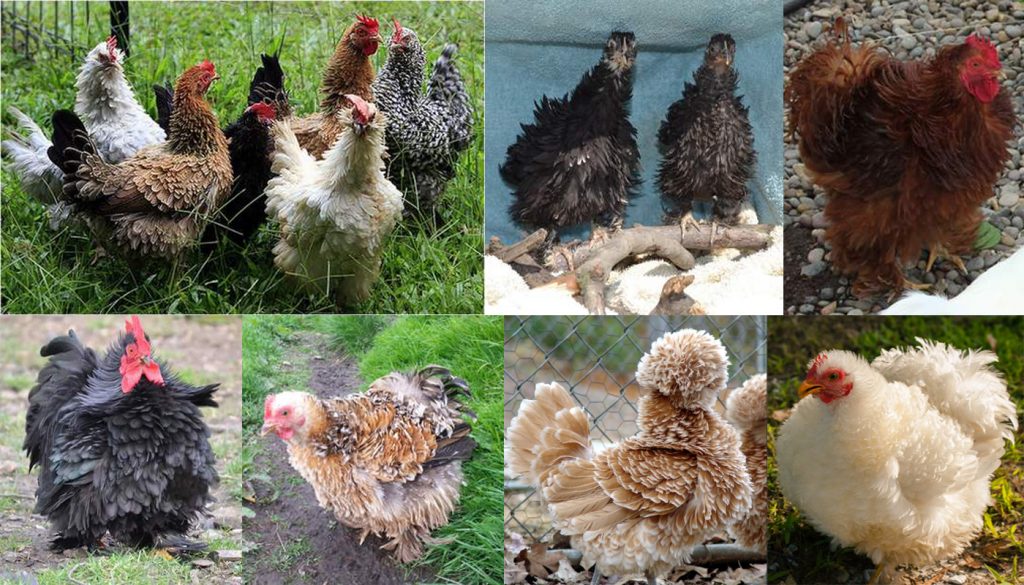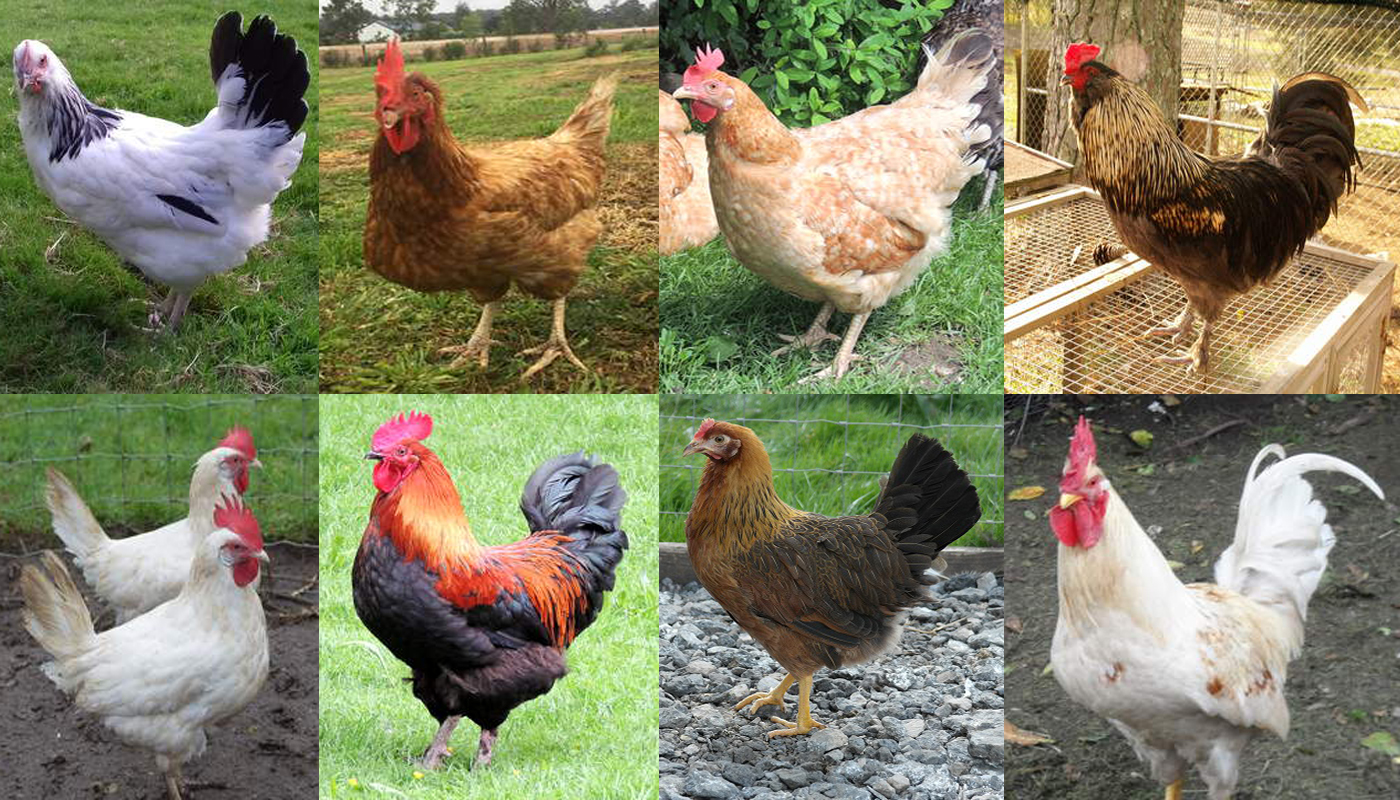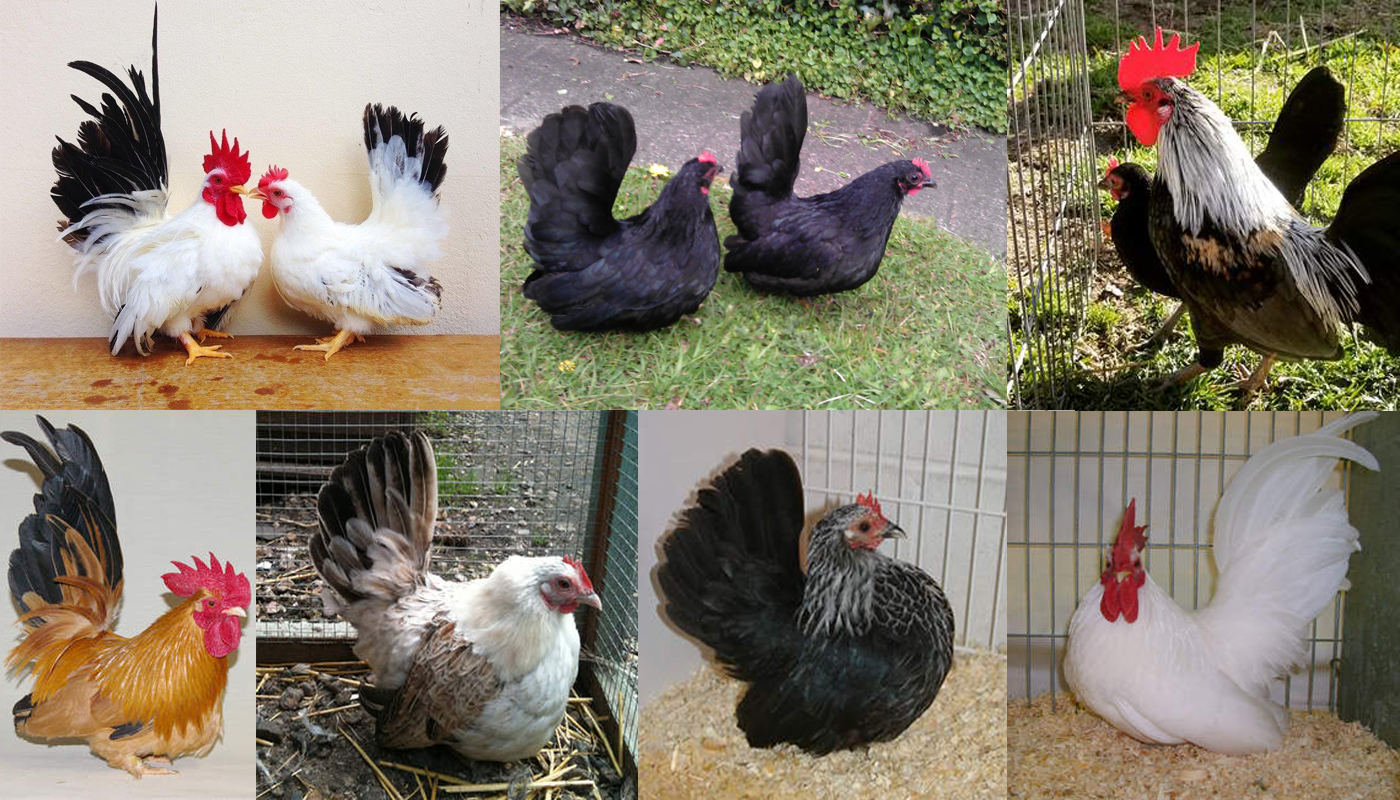
The frizzle is a chicken that has unique feathers that curly outwards and not flat against their body. These frizzled looking chickens are not bred for egg or meat purposes as they are not very big and do although they are great broody chicken they do not lay too many small eggs per year. They are mainly hobby, pet and exhibition chickens due to their beautiful array of colors.
These chickens have the sweetest nature and like to make friends with their humans.
A lot of countries, including America, do not so much recognize these unique chickens as a breed but rather a type.
This is because the gene that makes their feathers curl is found in other different breeds of chickens.
| Country of Origin: | Asia |
| American Poultry Association: | They are not Recognized as a breed of chicken in the United States |
| Chicken Category: | Not categorized |
| Chicken Class: | Not classed |
| Bantam Variety Available? | Yes – Feathered Legged Bantam Classification |
| Related | TOP 10 BANTAM CHICKEN BREEDS FOR BEGINNERS |
| Good Starter Chicken? | They can make great starter chickens as they have a lovely calm quiet personality. |
| Related | 10 BEST STARTER CHICKENS FOR THE FIRST TIME POULTRY KEEPER |
PURPOSE⇒ |
Eggs: The They are fairly good egg layers.
They lay small Bantam sized light brown eggs from 150 per year They will lay consistently throughout the year They start to lay eggs from around 22 weeks old.
Meat: They are not meant as table birds
Breeding: They can be bred as the hens do get broody. They are also making excellent little mothers and brood hens.
If you are breeding the Frizzle for show choosing the correct hens and rooster bloodline is crucial. It should also be noted that breeding a Frizzle with a Frizzle will cause the chicks to be almost bald. It is best to breed a Frizzle with a chicken with straight feathers. They do not breed true and there will be a mix of frizzled and straight feathered chicks. Breeding a Frizzle with a Silkie creates what breeders like to call as Sizzle.
Foraging: They love to scratch and forage about. But do well in confinement.
Show Bird: Their unique plumage, regal bearing and size make them excellent show birds.
Pets: Their sweet docile calm natures make them excellent pets
Other: They are a delightful little bird that adds a sparkle to any flock.
|
| Flyers? | Due to the shape of their feathers, the Frizzle cannot fly |
| Noisy Birds? | They are rather quiet little birds |
| Interaction with other chickens: | They get along well with other breeds. As with any flock if you are introducing new birds it is best to slowly socialize them with the flock. |
| Good with kids? | Their gentle calm nature makes them a great pet to have around supervised children. |
| Related | 10 ROOSTER BREEDS THAT DO NOT MIND CHILDREN |
HISTORY
The cute, sweet little Frizzle is not classified as a breed due to the characteristics with make its feathers curl is a genetic one. It is also a gene that is found in a lot of other normal feathered chicken breeds and is why when breeding a Frizzle, it needs to be bred with a straight feathered chicken. Not breeding true means that only half of the chicks will have frizzled feathers with the other half will be split with having normal feathers or over frizzled feathers.
It is not very clear about the history of the Frizzle or where it originally came from, but it is believed that were mainly found in the Philippines and India in the 18th century.
As they are not classified as a breed they are not recognized by the American Poultry Association.
CHARACTERISTICS |
|
|---|---|
IDENTIFICATION⇒ |
Appearance/Body: These cute little birds have a rounded body, little to no or a fluffy tail and red comb, wattles and earlobes. The feather curls outwards giving them a shaggy unbrushed look.
Color(s) They come in many colors some of the more popular ones being: white, red, black, blue, cuckoo, buff and Columbian.
Comb: They have a single comb
Ave. Weight: Pullet/Hen 24 – 26 oz
Cockerel/Rooster 26 – 30 oz |
| Life Expectancy: | The average lifespan is 6 – 8 years |
| Health: | They have no known health issues and are quite a hardy little bird. But due to their curly feathers, they do need extra protection in the cold as their feathers are not very protective. |
| You may Also Like: | HOW TO TELL IS A CHICKEN IS SICK |
| Temperament: | Gentle calm and friendly little chickens |
| Socialize Behavior? | They get along well with some other animals |
| You may Also Like: | HOW TO SOCIALIZING YOUR NEW CHICKENS |
| Known predators: | Keep an eye on eye on dogs and cats. If hawks and or foxes are in your area it is always best to take precautions. They tend to be easy targets for most feathery predators. Check with local animal shelters, zoos, vets, animal control and or pet stores about common predators in your area. |
| Conservation Status: | These birds conservation status is recorded as “recovering”. It is best to check on any special license or instructions that may be set up for owning these birds. This can be checked with your local or national conservation centers. These birds were nearly extinct at one stage, but their numbers have been increasing nicely due to the interest of avid breeders. |
IDEAL ENVIRONMENT |
|
|---|---|
| Garden Size: | They adapt well to most sized gardens and take confinement well. They do like to free range and forage about but feel safer closer to their coop. |
| Ideal Climate: | They are hardy little birds but do not handle the cold very well. |
| Ideal Coop: | The rule of thumb for any coop is 50 cm x 50 cm per hen/rooster in the coop. Ensure there is a good space for the nesting boxes and nightly roosting rails at least 1.5 inches wide. Good ventilation for air but not too drafty especially in winter. It is always a good idea to raise the coop off the ground to give the birds a dry place to roost and lay especially in wet weather. |
| Ideal Coop Run: | Frizzle is a small chicken that cannot fly due to the formation of their feathers. Although it should not be necessary to fully over the coop run it is always advisable to ensure the safety of the chickens from predators. |
| Ideal Flock Size: | They are quite happy in any size flock size, but it is always best to have more than one chicken. |
| Special Instructions: | No special instructions or requirements except to keep them warm in winter. |
| Accessories: | The following accessories are ideal for your coop: Nesting boxes Straw for the boxes and roosting area Roosting rails Perches Water troughs/bowls Food bowls/feeders Heating lamp(s) Animal carrier for transport purposes |
| You may Also Like: | 45 FREE DIY CHICKEN COOP PLANS, TUTORIALS AND DESIGNS |
WHERE TO FIND THESE BIRDS TO ADD TO YOUR FLOCK
The Frizzle Bantams are quite popular, so you may very well be able to find these chickens for sale at some live poultry outlets and farms, and internet outlets like Purely Poultry but for the best stock especially for breeding purposed it is always best to find local breeders clubs. These clubs have a wealth of information and lists of local breeders that can help with the requirements and care your chickens will need. If you plan on breeding your chickens, you will want to make sure that they are from a good bloodline.
CARING FOR THE BIRD(S)
Please click here for our full guide to “Taking care of chickens”. This is a comprehensive guide to owning chickens. It covers where to start from choosing your ideal flock, the coop that would best suit your garden, your bird and you to buying and bringing your bird(s) home.
GENERAL
Except for a bit more warmth and care in the winter months they are a low maintenance bird that is a delight to add to any flock.
GROOMING
These little chickens do love their dust bath and will love some added herbal essences mixed into the loose sand to help with pests and excess feather oils. They do not mind being handled and getting attention from their owners, so it should not be too much of a problem to check them for mites, lice and various other parasites. Checking for these pests in their feathers should be done at least once a week to your chickens healthy. Always get your birds de-wormed on a regular basis especially if they are around other animals or interacting with kids.
DIET AND NUTRITION
Give your Frizzle a balanced diet of chicken pellets, grains, chicken mash or grain mix from 8 weeks old and older. This should be fed to them first thing in the morning before they are let out to roam about to ensure they are getting all their nutrients.
For baby chickens, the best is always Chick Starter when they are under 8 weeks old.
Laying hens should get extra protein and calcium in their diets to ensure the quality of their eggs and to keep them in tip-top health.
Frizzle does love getting table scraps in the form of vegetables and fruit. They find these scraps even better if they are served as ice-cubes on very hot days.
Feeding your chickens correctly will give your organic garden a lot of nutritious fertilizer to make your vegetables or flowers grow.
Please see our comprehensive guide to “Feeding your chickens” for more information of the different types of chicken feed for chicks, hens, laying hens, roosters, etc. and where to buy the feed and approximate cost of the feed.
SOCIALIZING THE BIRD(S)
Frizzle is not a difficult bird to socialize as they are good-natured friendly little birds. But they are not overly large nor are they aggressive birds. If you are going to have a mixed flock, try some medium sized chicken breeds that have an accommodating friendly nature to compliment the Frizzle.
Always check on how well a breed will get on with your current flock before buying them as you do not want to upset your coop or stress your current flock.
As with any newcomer to the roost, you will have to quarantine the bird for 7 – 31 days to ensure it does not have any unwanted critters or disease that could spread to your current flock.
Even though they are gentle sociable birds, even they have a pecking order, so it is advisable to socialize them slowly and determine when it is right to allow the newcomer(s) to become a permanent part of the flock.
NOTES / SPECIAL INSTRUCTIONS
As they were once registered as an “extinct” conservation status they may need an extra license to own or keep in your garden. For advice on what the bird’s conservation status and orders are please check with your local conservation department.
Their feather may need some extra attention as might their skins in both the cold and heat. Their feathers curl does not give the chicken a lot of protection against the elements.
For breeders, it is imperative that you always check your bird’s bloodlines and ensure you are buying your birds from a reputed breeder/farm. In order to sell birds of such stature, they have to be recorded and documented, always check with local animal breeding organizations for these records.
These legitimate documents are also required should you wish to show your bird(s) in various poultry shows/competition showings.
For information and advice on adopting rescued animals, you can visit or contact your local animal welfare center.
Video
USEFUL LINKS
- Caring for your Chicken
- Feeding
- Health
- Socializing your Chicken
- Breeding Chicken
- Raising Chickens A-Z
- Hatching Eggs
- What is Molting
- Animal Shelter (ASPCA)
- American Veterinary Medical Association
- American Poultry Association
- American Animal Welfare Society
- American Animal Control
- American Animal Husbandry Society
References
- https://en.wikipedia.org
- https://livestockconservancy.org
- https://www.roysfarm.com
- https://www.mypetchicken.com
- https://www.backyardchickens.com
- https://www.feathersite.com/
 CONDITIONS THAT AFFECT THE A CHICKENS FEATHERS
CONDITIONS THAT AFFECT THE A CHICKENS FEATHERS Java Chicken Breed – Everything You Need to Know
Java Chicken Breed – Everything You Need to Know Feathers Across Borders: Discover 15 Unique Chicken Breeds Worldwide
Feathers Across Borders: Discover 15 Unique Chicken Breeds Worldwide Australorp Chicken Breed – Everything You Need to Know
Australorp Chicken Breed – Everything You Need to Know 10 Chicken Breeds that Make the Best Starter Chickens for the First Time Poultry Keeper
10 Chicken Breeds that Make the Best Starter Chickens for the First Time Poultry Keeper Modern Game Chicken Breed – Everything You Need to Know
Modern Game Chicken Breed – Everything You Need to Know Buckeye Chicken Breed – Everything You Need to Know
Buckeye Chicken Breed – Everything You Need to Know Ayam Cemani Chicken Breed – Everything You Need to Know
Ayam Cemani Chicken Breed – Everything You Need to Know Japanese Bantam Chicken Breed – Everything You Need to Know
Japanese Bantam Chicken Breed – Everything You Need to Know The Essential Guide to Keeping Your Chickens Healthy: Tips for Beginners
The Essential Guide to Keeping Your Chickens Healthy: Tips for Beginners Chicken Vaccinations and why they are Important to a Flock
Chicken Vaccinations and why they are Important to a Flock Color Varieties that are found in a lot of the Various Chicken Breeds
Color Varieties that are found in a lot of the Various Chicken Breeds